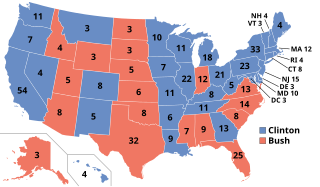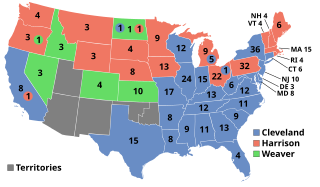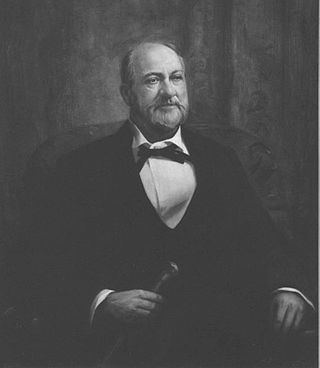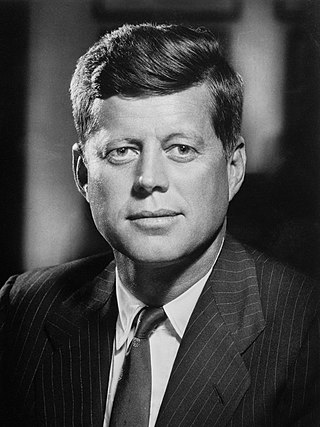
The 1996 United States presidential election was the 53rd quadrennial presidential election, held on Tuesday, November 5, 1996. Incumbent Democratic President Bill Clinton defeated former Senate Majority Leader Bob Dole, the Republican nominee, and Ross Perot, the Reform Party nominee and 1992 Independent presidential candidate.

The 1992 United States presidential election was the 52nd quadrennial presidential election, held on Tuesday, November 3, 1992. Democratic Governor Bill Clinton of Arkansas defeated incumbent Republican President George H. W. Bush and independent businessman Ross Perot of Texas. The election marked the end of a period of Republican dominance in American presidential politics that began in 1968,, and also marked the end of 12 years of Republican rule of the White House, as well as the end of the Greatest Generation's 32-year American rule and the beginning of the baby boomers' 28-year dominance until 2020. It was the last time the incumbent president failed to win a second term until Donald Trump in 2020.

The 1852 United States presidential election was the 17th quadrennial presidential election, held on Tuesday, November 2, 1852. Democrat Franklin Pierce defeated Whig nominee General Winfield Scott. A third party candidate from the Free Soil party, John P. Hale, also ran and came in third place, but got no electoral votes.

The 1856 United States presidential election was the 18th quadrennial presidential election, held on Tuesday, November 4, 1856. In a three-way election, Democrat James Buchanan defeated Republican nominee John C. Frémont and Know Nothing nominee Millard Fillmore. The main issue was the expansion of slavery as facilitated by the Kansas–Nebraska Act of 1854. Buchanan defeated President Franklin Pierce at the 1856 Democratic National Convention for the nomination. Pierce had become widely unpopular in the North because of his support for the pro-slavery faction in the ongoing civil war in territorial Kansas, and Buchanan, a former Secretary of State, had avoided the divisive debates over the Kansas–Nebraska Act by being in Europe as the Ambassador to the United Kingdom.

The 1892 United States presidential election was the 27th quadrennial presidential election, held on Tuesday, November 8, 1892. In the fourth rematch in American history, former Democratic President Grover Cleveland defeated incumbent Republican President Benjamin Harrison. Cleveland's victory made him the first and, to date, the only person in American history to be elected to a non-consecutive second presidential term. It was also the first of two times incumbents were defeated in consecutive elections—the second being Jimmy Carter's defeat of Gerald Ford in 1976, followed by Carter's subsequent loss to Ronald Reagan in 1980. It was the first election since 1856 in which one former president ran against the incumbent president, an event not repeated until 1912.

The 1896 United States presidential election was the 28th quadrennial presidential election, held on Tuesday, November 3, 1896. Former Governor William McKinley, the Republican nominee, defeated former Representative William Jennings Bryan, the Democratic nominee. The 1896 campaign, which took place during an economic depression known as the Panic of 1893, was a political realignment that ended the old Third Party System and began the Fourth Party System.

The 1908 United States presidential election was the 31st quadrennial presidential election, held on Tuesday, November 3, 1908. Republican Party nominee William Howard Taft defeated three-time Democratic nominee William Jennings Bryan.

The People's Party, also known as the Populist Party or simply the Populists, was a left-wing agrarian populist political party in the United States in the late 19th century. The Populist Party emerged in the early 1890s as an important force in the Southern and Western United States, but collapsed after it nominated Democrat William Jennings Bryan in the 1896 United States presidential election. A rump faction of the party continued to operate into the first decade of the 20th century, but never matched the popularity of the party in the early 1890s.

The American Independent Party (AIP) is a far-right political party in the United States that was established in 1967. The AIP is best known for its nomination of Democratic then-former Governor George Wallace of Alabama, who carried five states in the 1968 presidential election running on a populist, hard-line anti-Communist, pro-"law and order" platform, appealing to working-class white voters and widely understood by political analysts as having pro-segregationist or white supremacist undertones, against Richard Nixon and Hubert Humphrey. In 1976, the party split into the modern American Independent Party and the American Party. From 1992 until 2008, the party was the California affiliate of the national Constitution Party. Its exit from the Constitution Party led to a leadership dispute during the 2008 election.

Edward Hazzard East was an American attorney, judge, and politician. He served as Secretary of State for the state of Tennessee from 1862 to 1865, having been appointed by Andrew Johnson, the state's military governor under the Union Army occupation during the Civil War. East briefly served as the state's acting governor during the interim between Johnson's inauguration as U.S. Vice President on March 4, 1865, and the inauguration of the state's "elected" governor, William G. Brownlow, on April 5, 1865.

John Price Buchanan was an American politician and farmers' advocate. He served as the 25th governor of Tennessee from 1891 to 1893, and was president of the Tennessee Farmers' Alliance and Laborers' Union in the late 1880s. Buchanan's lone term as governor was largely marred by the Coal Creek War, an armed uprising by coal miners aimed at ending the state's convict lease system.

Peter Turney was an American politician, soldier, and jurist, who served as the 26th governor of Tennessee from 1893 to 1897. He was also a justice of the Tennessee Supreme Court from 1870 to 1893, and served as the court's Chief Justice from 1886 to 1893. During the Civil War, Turney was colonel of the First Tennessee Regiment, one of the first Tennessee units to join the Confederate Army.

The 1964 United States Senate elections were held on November 3. The 33 seats of Class 1 were contested in regular elections. Special elections were also held to fill vacancies. They coincided with the election of President Lyndon B. Johnson by an overwhelming majority, to a full term. His Democratic Party picked up a net two seats from the Republicans. As of 2023, this was the last time either party has had a two-thirds majority in the Senate, which would have hypothetically allowed the Senate Democrats to override a veto, propose constitutional amendments, or convict and expel certain officials without any votes from Senate Republicans. In practice, however, internal divisions effectively prevented the Democrats from doing so. The Senate election cycle coincided with Democratic gains in the House in the same year.

From March 8 to June 7, 1960, voters and members of the Democratic Party elected delegates to the 1960 Democratic National Convention through a series of caucuses, conventions, and primaries, partly for the purpose of nominating a candidate for President of the United States in the 1960 election. The presidential primaries were inconclusive, as several of the leading contenders did not enter them, but U.S. Senator John F. Kennedy of Massachusetts emerged as the strongest candidate and won the nomination over Lyndon B. Johnson at the convention, held from July 11 to 15 at the Los Angeles Memorial Sports Arena.

The 1894 South Dakota gubernatorial election was held on November 6, 1894. Incumbent Republican Governor Charles H. Sheldon ran for re-election to a second term. Despite facing a thread of defeat at the Republican convention, Sheldon was renominated unanimously. In the general election, he faced Populist nominee Isaac Howe, a Spink County Judge; James A. Ward, the former state chairman of the South Dakota Democratic Party; and Prohibition nominee M. D. Alexander. The election was largely a replay of the gubernatorial elections of 1890 and 1892, with the Farmers' Alliance candidate placing second and the Democratic nominee placing a distant third. This time, however, Sheldon won an outright majority and the Democratic Party's vote share shrunk to just 11%, its worst performance in state history.

The 1895 New Jersey gubernatorial election was held on November 5, 1895. Republican nominee John W. Griggs defeated Democratic nominee Alexander T. McGill with 52.28% of the vote.

The 1892 United States presidential election in Tennessee took place on November 8, 1892. All contemporary 44 states were part of the 1892 United States presidential election. Tennessee voters chose twelve electors to the Electoral College, which selected the president and vice president.

The 1970 Maryland gubernatorial election was held on November 3, 1970. Incumbent Democrat Marvin Mandel defeated Republican nominee Charles Stanley Blair with 65.73% of the vote. This election was the first of eight consecutive Democratic gubernatorial victories in Maryland, a streak not broken until the election of Republican Bob Ehrlich in 2002.

The 1894 Tennessee gubernatorial election was held on November 6, 1894. Incumbent Democratic Governor Peter Turney defeated former congressman and Republican nominee Henry Clay Evans with 45.06% of the vote.

A general election was held in the U.S. state of Wyoming on Tuesday, November 6, 1894. All of the state's executive officers—the Governor, Secretary of State, Auditor, Treasurer, and Superintendent of Public Instruction—were up for election. The Republican Party, helped by the strong performance of the Populist Party, which operated as a spoiler to the Democratic Party, won back the governorship and improved its margin of victory in all other statewide offices.






















